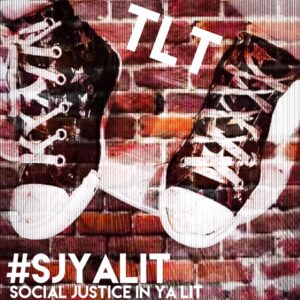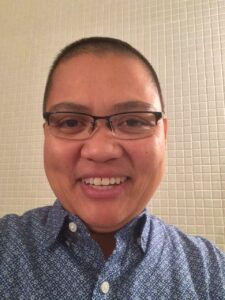#SJYALit Hello, I’m Your Social Justice Librarian, a guest post by Perlita Payne
 I became the Social Justice Librarian at Alameda County Library in September. I had gotten my MLIS the year before while working for many years at a health center in an urban high school. After graduation, I was an hourly Reference Librarian at a couple of public library systems including the one that I now work for full-time. I have always worked to create safe and welcoming spaces for those at the intersections of marginalized communities be they young people, those who have been incarcerated or detained, people of color, immigrants, women, LGBTQ, and people with disabilities. I am also a proud member of these communities.
I became the Social Justice Librarian at Alameda County Library in September. I had gotten my MLIS the year before while working for many years at a health center in an urban high school. After graduation, I was an hourly Reference Librarian at a couple of public library systems including the one that I now work for full-time. I have always worked to create safe and welcoming spaces for those at the intersections of marginalized communities be they young people, those who have been incarcerated or detained, people of color, immigrants, women, LGBTQ, and people with disabilities. I am also a proud member of these communities.
Alameda County is the seventh largest county in the State of California with 14 incorporated and unincorporated cities and a population of 1.5 million (“About”). At Social Justice Services (SJS), we provide library services and programs at the adult jails (Santa Rita and Glenn Dyer), Juvenile Justice Center (JJC), Camp Sweeney (minimum security residential program for young men), and three social services sites that are part of our Pop-Up Library Services for Everyone (PULSE) Program. At the adult jails, right now, we have bookcarts and/or bookshelves at each housing units that we replenish throughout the month. Inmates can also fill out request forms for books and magazines that they would like and we fulfill them as appropriate. We also have a family program called “Start With a Story” (SWAS) during visitations on the weekends. Our SWAS volunteers give brand new picture books to and do storytimes with the children waiting to visit their incarcerated parents and/or guardians. At juvenile hall and Camp Sweeney, we have a library at each of these sites with a Librarian on duty providing scheduled services every week. Similar to the adult jails, we also have bookshelves at each of the housing units that the Librarian replenishes. We also have a poetry writing program at Camp Sweeney run by library staff. At each of our Pop-Up Library Services (PULSE) sites, we have a book vending machine that holds over 200 books at any given time and these are replenished by staff throughout the month. Our PULSE patrons suffer from chronic homelessness and for many reasons they find it challenging to get to a brick-and-mortar library and sign up for traditional library services, and so we bring the library to them via our book vending machines.
ADVERTISEMENT
ADVERTISEMENT
I am charged with creating programs and events for all of our sites. For the sake of TLT, I will just talk about my work with teens.
The Juvenile Justice Center (JJC) is a detention center for up to 358 minors. Camp Sweeney is a rehabilitative, minimum security, residential program for up to 50 young men 15-19 years old (“Probation”). With changes in sentencing laws and options other than detention (e.g., electronic monitoring), the number of teens have gone down at each of these sites.
At JJC, I meet monthly with the probation officer in charge of programs and our embedded Librarian to discuss programs and needs. We are very fortunate to be located in the San Francisco Bay Area, where there are many organizations and individuals who volunteer at JJC to carry out programs ranging from yoga to beats-making classes. There is a school at JJC and the teens attend classes during the week. The probation officer in charge of programs has access to the school calendar and I work closely with her to schedule the programs during the school day.
In December, she had requested a program during intersession. Using a vendor from the County Art Commission, I was able to bring a pop-up greeting card program to JJC. Although the date that the art vendor had available was after Christmas, the skills that the teens picked up can still be used to make other kinds of greeting cards throughout the year. Every performer and artists need to fill out a Visitor’s Request form that get processed by JJC. For the art vendor, I also needed to get her materials approved. She sent me a list of the items that she would like to bring. I also asked her to hold on to this same list and check it when the class ends to make sure she has all of them. If there’s anything missing, of course, there will be a search and that’s never anything we would want. For card making, we were allowed to bring kids scissors with rounded ends, colored pens, ink stamps, and a selection of shape punches. The vendor put in a last minute request to bring one pair of scissors with a pointed edge for her personal use only. I emailed the probation officer with fingers crossed and thankfully, this was approved.
Crafting was a big hit for the teens and also the officers assisting that day. Outside of shadowing Andrew, our embedded Librarian, while he made the rounds through the housing units, this was the first time I had been with the teens for an extended amount of time. And you know what? Teens are teens wherever they might be. They came shuffling in looking uninterested, bored and left with finished pieces that I almost mistook for the art vendor’s samples. They crowded around the punches to make shapes like stars, horses, and crowns, all the while exclaiming how “tight” their pieces were going to be. For an hour and a half we were all in an art class and their creativity was limitless. I heard much laughter and banter among the teens. Of course, when class was over, we were back to reality: we had to count the materials to make sure what we had was exactly what we came in with. Everything counted out right and the teens left after we thanked them for participating. I heard from the probation officer that the teens were really proud of the cards they made and some of the officers who were there that day showed the teens in the housing units that didn’t get to attend how to make the cards. All of these were heartening to hear. And I have since booked the art vendor to come back for three more classes! We need more opportunities for art everywhere but especially at JJC.
In February, at JJC, we will be celebrating Black History Month by having Kirk Waller, a local storyteller, to perform to four housing units which can mean up to 80 teens attending. I also have scheduled Aya De Leon, a spoken word artist and Dr. Joseph Marshall, an author who’s been at the forefront of violence prevention conversations in the San Francisco Bay Area. In the Summer, we will be working with Dave Egger’s non-profit, Voice of Witness and 826 Valencia on a memoir writing workshop at all of our sites as a way to give space to and amplify marginalized voices. I am currently taking a MakerSpace workshop class and I have plans on creating a MakerSpace at JJC. I don’t know what our MakerSpace will look like yet but Andrew and I have been talking about teaching podcasting and starting a podcast with the teens. I’m also looking at bringing in Girls Who Code because they rock and why not? I have a lot cooking here at JJC and I’m so very excited about every bit of it.
I’ve been thinking about books that might be helpful for folks who do not work with patrons who are in detention. The truth is, many of our patrons may have been in detention when they were young or know someone who is or has been in detention. Their stories have been made invisible because of shame and the stigma of having been incarcerated or detained. When I accepted my position, I read Jimmy Santiago Baca’s autobiography “A Place to Stand”. Growing up, Baca was in and out of jail and spent 5 years in prison for drug charges. His accounting of life in prison as a young Latino is harrowing. I have noticed that many juvenile hall libraries carry this book because it is inspiring that during Baca’s time in prison, he was able to teach himself how to read and became the great poet that he is now. I also read Richard Ross’s “Girls in Justice” which is a photo book focused on young women in detention around the country (the County that I work for is featured in it). It is a sobering, heartbreaking book with pictures that are meant to be pored over slowly so as to be respectful of the teen in detention brave enough to be part of the project. I’ve also read “Pushed Out” by Monique Morris which is focused on the effects of the school to prison pipeline on African-American girls. This book goes well with Marc Lamont Hill’s “Nobody” which covers police shootings in Ferguson and the Black Lives Matter movement. And I have to include Ta-Nehisi Coates’ “Between The World & Me” because the author wrote it with so much sincerity to his teenage son. It is a kind of manual on how to thrive as a Black Man in American in spite of racism and State violence. I also found books about queer and trans people in prison, one is by Dean Spade’s “Normal Life” and the other is “Captive Genders” edited by Eric Stanley. I found particularly powerful Wesley Ware’s article about the struggles of queer and trans youth in juvenile halls in Louisiana. It is such a great time for publishing right now and so many excellent books are coming out. These are just mere starting points.
“About Alameda County ” https://www.acgov.org/about/
“Probation Department” http://www.acgov.org/probation/ji.htm
“Social Justice Services” http://www.aclibrary.org/content/social-justice-services
Filed under: #SJYALit
About Robin Willis
After working in middle school libraries for over 20 years, Robin Willis now works in a public library system in Maryland.
ADVERTISEMENT
ADVERTISEMENT
SLJ Blog Network
The Moral Dilemma of THE MONSTER AT THE END OF THIS BOOK
Cover Reveal and Q&A: The One and Only Googoosh with Azadeh Westergaard
K is in Trouble | Review
Fighting Public School Book Bans with the Civil Rights Act
ADVERTISEMENT









Great, an SJW as a librarian. I am so thrilled
Dave, I’m detecting some sarcasm in your comment; not sure if you’re trolling because you’re bored or if I’m misreading what you wrote (hopefully that’s the case – if so, I’m sorry). But anyway, great piece; thanks for doing what you do, Perlita!